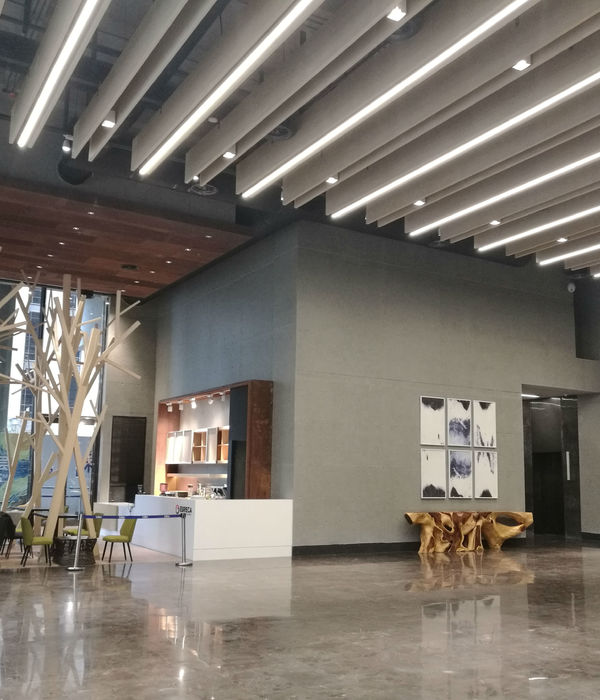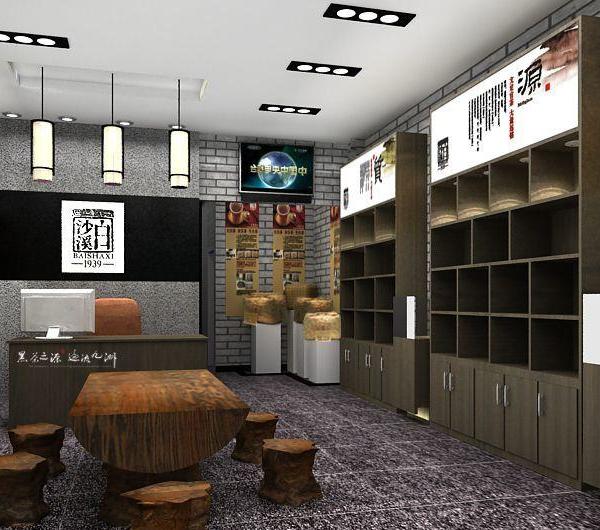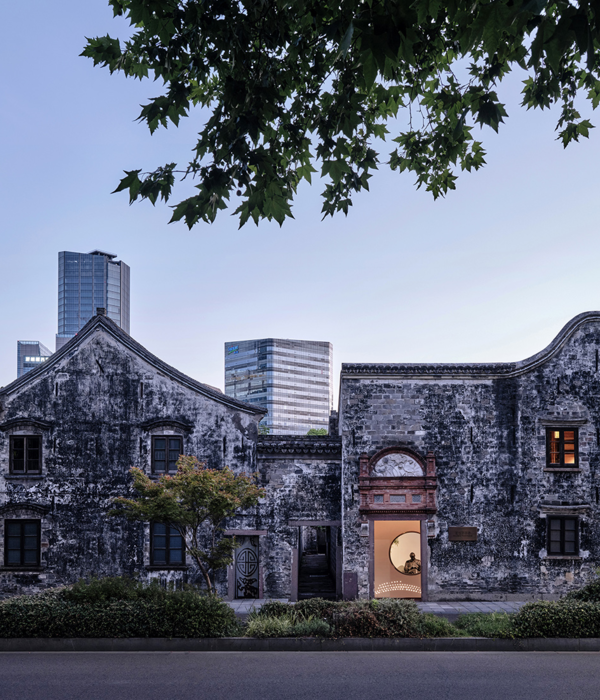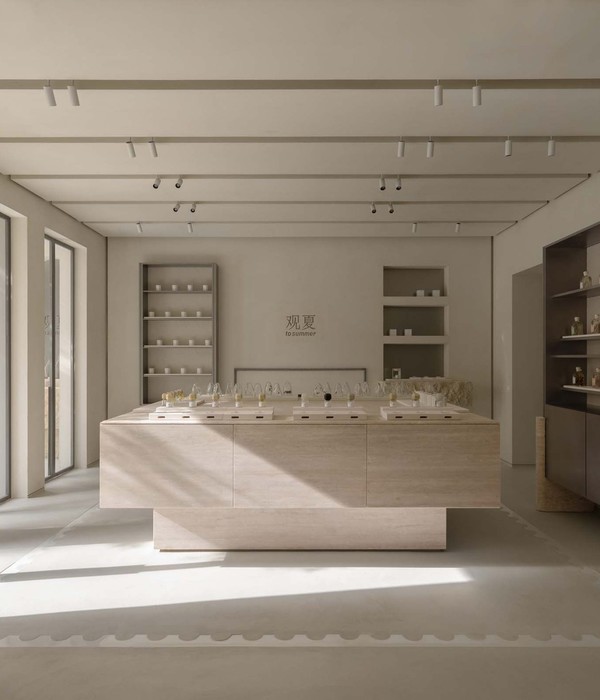东江自北向南流经河源市区,新丰江从西向东绕城而过,两江在河源市区东面交汇,使得整个河源市区三面环水,因而得名河源,这里是广东客家人聚居的地区。发昌村位于河源市紫金县东北侧,村里最有名的事迹大概是孙中山的族人早年到广东曾经在这有过短暂的停留,村里为此建了中山纪念小学,是村里为数不多的公共建筑(另一个就是祠堂)。如今村里大多壮年都已外出城里务工,留下来的大多是老年人与儿童,这些人也成为新建的社区中心的主要使用者。
The Dongjiang River flows through Heyuan city from north to south, and the Xinfeng River circles the city from west to east. The two rivers meet in the east of Heyuan city, making the whole city surrounded by water on three sides, hence the name Heyuan. This is a hakka area in Guangdong. Located in the northeast of Zijin County, Heyuan, Fachang village is probably best known for the brief stay of Sun yat-sen’s people in the early years. For this reason, Zhongshan memorial primary school was built, which is one of the few public buildings in the village (another is the ancestral hall). Most of the village’s young people are now migrant workers in the city, leaving behind mostly the elderly and children who have become the main users of the new community center.
▼鸟瞰图,aerial view ©张超
基地周边地块多为村舍和农田,地块大致呈梯形,中间被东西向村路横穿划分为南北两块。基地西南侧有小河,河的南侧是半月塘和祠堂;西北侧有山景,视野开阔;东侧的村路是进入场地重要道路,村路与场地之间是一片狭长的绿地,绿地内有两棵大树和一排竹子,再往东就是中山纪念小学。我们把南北地块作为一个整体考虑,南侧、东侧设砖砌矮墙,向西北侧山体打开,形成场地空间界定。村路东北侧砖墙与混凝土鹅卵石铺地围合出半月形广场,考虑为露天电影放映等多功能活动使用。
▼场地平面图,site plan
The plot of land is almost trapezoidal, surrounded by cottages and farmland, and is divided into north and south part by rural road. There is a small river to the southwest of the site, on the south side of the river are the half-moon pond and the ancestral temple. The northwest side of the site is visually open to the mountain. The rural road on the east side is an important road to enter the site. Between the rural road and the site is a strip of green space with two old trees and a row of bamboo. Further east is the Zhongshan memorial primary school. We took the two parts of the plot as a whole, close its south and east side with brick masonry wall, make it open toward the north-west mountain, forming a clear site definition. The brick wall and concrete cobblestone pavement on the northeast side of the rural road enclose a half-moon square, which is considered to be used for multi-functional activities, such as open-air cinema.
▼建筑外观,exterior view ©张超
▼木地板地面和混凝土鹅卵石铺地无缝连接, the wooden floor is seamlessly connected to the concrete cobblestone pavement ©张超
主体建筑置于西南侧梯形用地中央,置于架空木地板的支座上,考虑到功能主要为老人和儿童使用木地板地面与室外场地无缝连接。东北侧结合围墙设置公共卫生间,设置在主体建筑之外。社区中心主体4Mx4M跨柱网的正交框架3M高的使用空间,3M以上撑起1.5M三角形斜屋面,北向高侧窗采光,均匀稳定的光线进入室内,形成舒适的室内光环境;三角形低处设置200mmX200mm的“U”型钢槽作屋面排水设施。屋面出挑1.5M开敞外廊挑檐空间,形成场地覆盖。东北侧留出一跨架空处理形成主入口;西侧、南侧留有较大挑檐空间,形成与这两侧室外庭院的空间过渡,南侧檐口尽可能压低与近景的竹子和远景的山形成框景;东南侧檐口空间与矮墙形成狭长围合,透过镂空矮墙,原保留的东南侧的植物渗透进庭院内部,形成借景。室内空间划分灵活,适应未来使用需求的不确定性。
▼形态生成示意,massing diagram
▼三角形斜屋面,the triangular inclined roof ©张超
The main building is placed on an elevated wooden floor in the center of the trapezoidal land on the southwest. Considering that it is mainly used by the elderly and children, the wooden floor is seamlessly connected to the outdoor space. Public toilet is placed on the northeast side in combination with the enclosing wall outside the main building. The main body of the community center is an orthogonal frame of 4Mx4M column network, with 3 meter high space for use. The 1.5 meter triangular inclined roof is supported above 3 meter. Uniform and stable light enters the room from the north-facing high side window to form a comfortable indoor light environment. At the lower part of the triangle, 200mmx200mm “U” shaped steel groove is set as the roof drainage facility. The roof overhangs 1.5 meter, forming an open cornice space of the outer corridor. A span of overhead space on the northeast is formed to become the main entrance. Large overhanging eaves on the west and south form a space transition with outdoor courtyards. The southern cornice is kept as low as possible to frame the nearby bamboo and distant hills. The eaves space on the southeast side forms a long and narrow enclosure with the low wall. Through the hollow low wall, the reserved plants on the southeast side infiltrate into the courtyard to form a view borrowing. The interior space can be divided flexibly to adapt to the uncertainty of its future uses.
▼镂空矮墙围合的狭长庭院,the long and narrow enclosure with the low wall ©张超
▼东北侧结合围墙设置公共卫生间,设置在主体建筑之外,public toilet is placed on the northeast side in combination with the enclosing wall outside the main building ©张超
▼公共活动空间,public activity space ©张超
▼空间细部,detailed view ©张超
村野山水的基地特质,使我们采用了一种迥异于在城市的建造模式,转而使用自然的材料逻辑——木、砖为主材,以一种融入“自然”的方式介入对场地的改造,为留守的老人、儿童创造一个温暖的庇护所。建筑主体为木结构框架体系,选用南方松作为主材,为了减少建造的难度,我们规整梁柱截面尺寸,统一为200MMx200MM,杆件之间为榫卯交接。除了面向北侧村路一层外墙为有局部凸出的青砖砌体填充墙外,其余均为玻璃木框门扇辅以木条斜纹填充。地面用素混凝土砌筑斜向格构(方向与建筑屋顶天窗方向同),内部填充深色鹅卵石,用水泥粘接。
▼结构分析,structural analysis
The nature of the landscape in the village leads us to adopt a construction mode that is different from that in the city. Natural material (wood and brick as the main material) is used to intervene in the renovation of the site in a “natural” way to create a warm shelter for the leftover elderly and children. The main body of the building is a timber frame system, with southern pine as the main material. In order to reduce the difficulty of construction, we regulate the size of beam and column section, unified as 200mmx200mm, and the connection between the rods is mortise and tenon joint. Most of the outer wall are glass frame doors supplemented by wood twill filling, except for the outer wall of the first floor facing north rural road, which is filled with partially protruding blue brick masonry. The ground is built with plain concrete masonry inclined lattice (in the same direction as the building roof skylight) filled with dark cobblestones, which are bonded with cement.
▼从农田望向建筑,view from the farm land ©朱雄毅
▼建筑以木、砖为主材,以一种融入“自然”的方式介入场地,natural material (wood and brick as the main material) is used to intervene in the renovation of the site in a “natural” way ©张超
▼轴测图,axon
▼首层平面图,ground floor plan
▼剖透视图,sectional perspective
{{item.text_origin}}












